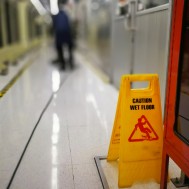Has your business recently undergone a scourge of injuries? Any workplace can be dangerous when it comes to the matter of slips, trips and falls. In the material handling industry, there are numerous factors that can cause and create incidents of this nature.
The good news is that there are a multitude of steps that any business can take to mitigate and prevent the next episode from occurring. Here are some of the most notorious culprits that commonly cause slip, trip and fall accidents in the workplace.
1. Improper lifting
There are many ways that this contributes to slip, trip and falls. First, improper handling of materials can cause an individual to be off balance. When it is combined with overexertion, many workers are also prone to musculoskeletal injuries before falls are even thrown into the equation.
The number one way to limit the effects of such a situation is by preventing personnel from lifting an object that is too heavy for them to lift on their own. Stressing teamwork and spotting is a great way to keep staff on their feet.
2. Physical conditioning
Tying in with the risks associated with fatigue, physical conditioning plays a huge role in shaping the potential pitfalls that can cause one of these injuries. Physical conditioning is synonymous with athletic proficiency. The better shape an individual is in, the more they can lift longer.
More often than not, many lift beyond their means and engage in physical activity beyond recommended doses. The result of this is muscle exhaustion which can lead to a collapse.
3. Velocity of travel
Very simply, when a worker is traveling at a speed that is faster than suggested when handling cumbersome materials, this raises the chance for a slip, trip or fall to occur. Given the speed they are moving at, the resulting effects can be enhanced.
When handling any item or negotiating tight or dark spaces, advise and stress the importance of doing so safely and slowly. While productivity and efficiency may take a hit, safety awareness will be optimized.
4. Poor lighting
Though it may seem obvious, poor lighting can be instrumental in causing workplace accidents. Whether it be tiny items under the foot, hidden impediments or poor traction due to limited visibility, all of these conditions curate the possibility of a slip, trip or fall. The results can be catastrophic. However, they can also be prevented. Installing up-to-date LED lighting is a great way to mitigate risks associated with this trouble spot.
5. Wet floors
Slick floors or high-traffic corridors can cause a trip or fall. In addition to this, improper footwear can also raise the risk of such an event. Trips and falls are a commonality but in many instances, they can cause injuries or workman’s compensation claims. The good news is there are proactive measures one can take to avert these scenarios.
According to EHS Today, calculating slip coefficient of friction is a great way to limit impacts. External to this algorithm, there are a few notable situations that are imminent threats. Ice on any surface, lubricants, and wet materials in transient form are some of the most regular causes of slip and falls that also raise SCOF. Placing a sign or notifying employees of their prevalence is a great way to reduce hazards.
Want to talk more about how to avoid workplace injuries? Tweet us at @AppleRubber.
Bio: Tom Reddon is a forklift specialist and blog manager for the National Forklift Exchange. He also sits on the Material Handling Equipment Distributors Association (MHEDA) Executive Dialogue team. Follow him on Twitter at @TomReddon
